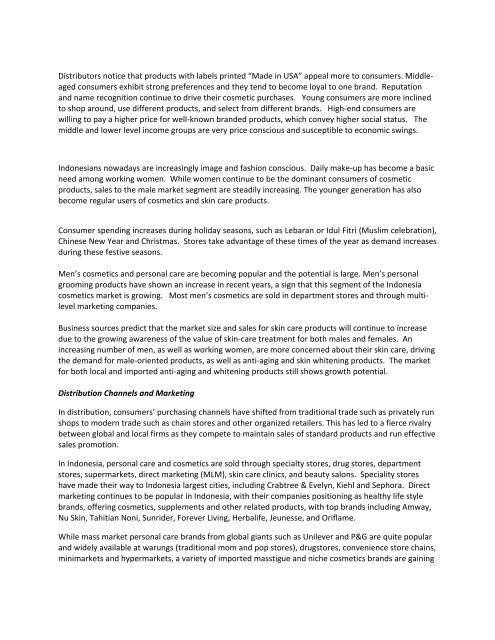Asia Personal Care & Cosmetics Market Guide 2016
AsiaCosmeticsMarketGuide
AsiaCosmeticsMarketGuide
Create successful ePaper yourself
Turn your PDF publications into a flip-book with our unique Google optimized e-Paper software.
Distributors notice that products with labels printed “Made in USA” appeal more to consumers. Middleaged<br />
consumers exhibit strong preferences and they tend to become loyal to one brand. Reputation<br />
and name recognition continue to drive their cosmetic purchases. Young consumers are more inclined<br />
to shop around, use different products, and select from different brands. High-end consumers are<br />
willing to pay a higher price for well-known branded products, which convey higher social status. The<br />
middle and lower level income groups are very price conscious and susceptible to economic swings.<br />
Indonesians nowadays are increasingly image and fashion conscious. Daily make-up has become a basic<br />
need among working women. While women continue to be the dominant consumers of cosmetic<br />
products, sales to the male market segment are steadily increasing. The younger generation has also<br />
become regular users of cosmetics and skin care products.<br />
Consumer spending increases during holiday seasons, such as Lebaran or Idul Fitri (Muslim celebration),<br />
Chinese New Year and Christmas. Stores take advantage of these times of the year as demand increases<br />
during these festive seasons.<br />
Men’s cosmetics and personal care are becoming popular and the potential is large. Men’s personal<br />
grooming products have shown an increase in recent years, a sign that this segment of the Indonesia<br />
cosmetics market is growing. Most men’s cosmetics are sold in department stores and through multilevel<br />
marketing companies.<br />
Business sources predict that the market size and sales for skin care products will continue to increase<br />
due to the growing awareness of the value of skin-care treatment for both males and females. An<br />
increasing number of men, as well as working women, are more concerned about their skin care, driving<br />
the demand for male-oriented products, as well as anti-aging and skin whitening products. The market<br />
for both local and imported anti-aging and whitening products still shows growth potential.<br />
Distribution Channels and <strong>Market</strong>ing<br />
In distribution, consumers’ purchasing channels have shifted from traditional trade such as privately run<br />
shops to modern trade such as chain stores and other organized retailers. This has led to a fierce rivalry<br />
between global and local firms as they compete to maintain sales of standard products and run effective<br />
sales promotion.<br />
In Indonesia, personal care and cosmetics are sold through specialty stores, drug stores, department<br />
stores, supermarkets, direct marketing (MLM), skin care clinics, and beauty salons. Speciality stores<br />
have made their way to Indonesia largest cities, including Crabtree & Evelyn, Kiehl and Sephora. Direct<br />
marketing continues to be popular in Indonesia, with their companies positioning as healthy life style<br />
brands, offering cosmetics, supplements and other related products, with top brands including Amway,<br />
Nu Skin, Tahitian Noni, Sunrider, Forever Living, Herbalife, Jeunesse, and Oriflame.<br />
While mass market personal care brands from global giants such as Unilever and P&G are quite popular<br />
and widely available at warungs (traditional mom and pop stores), drugstores, convenience store chains,<br />
minimarkets and hypermarkets, a variety of imported masstigue and niche cosmetics brands are gaining

















